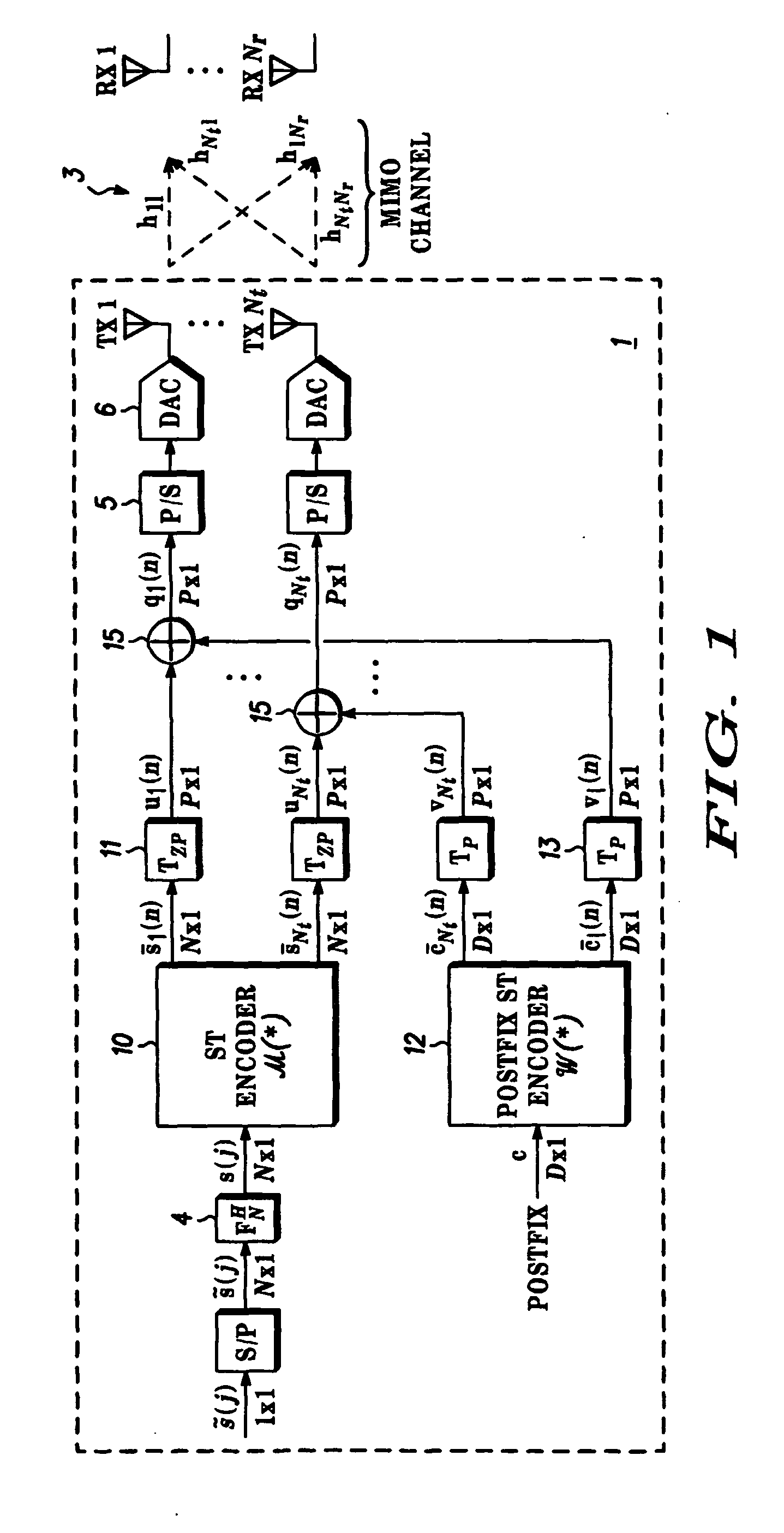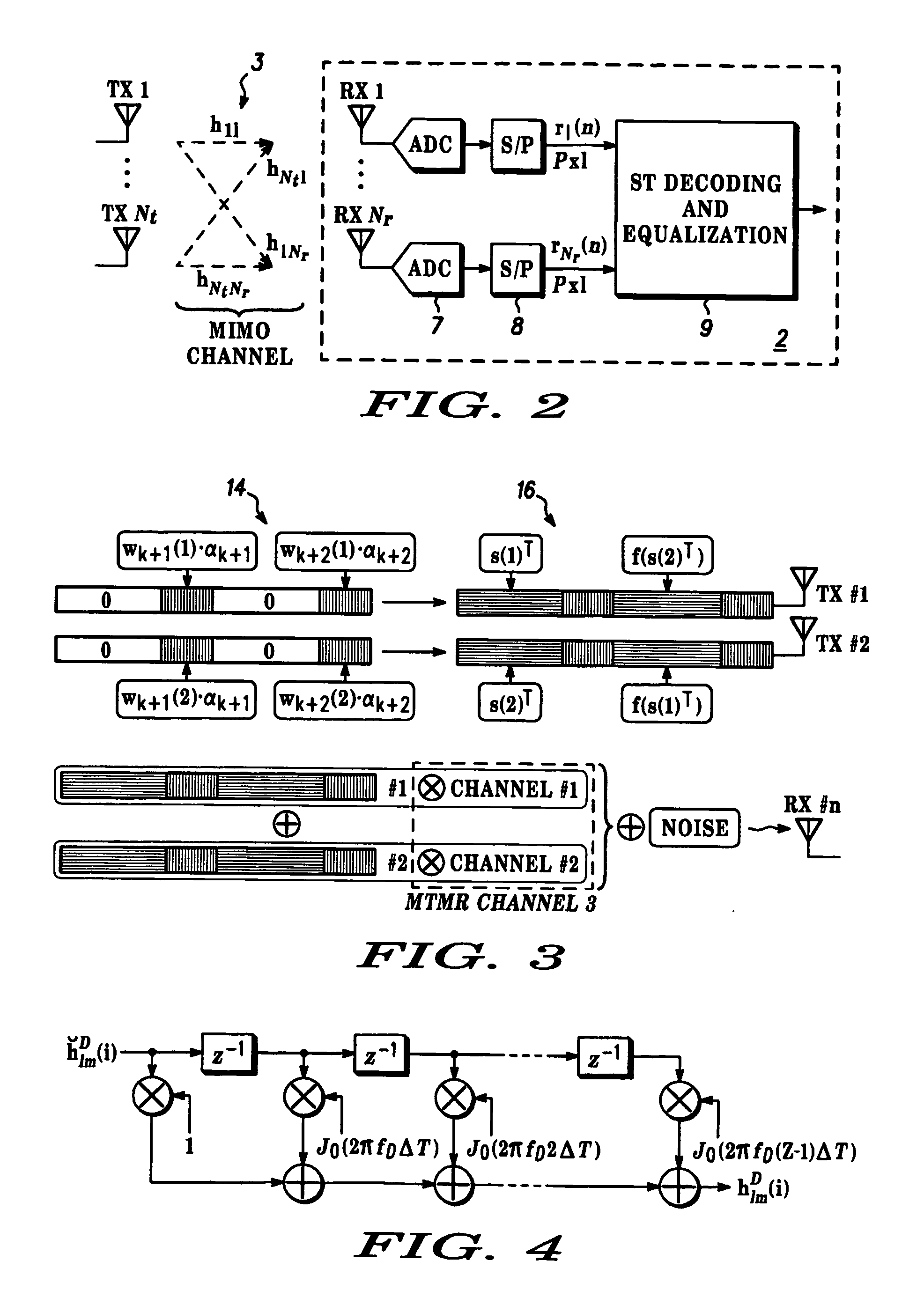Ofdm Channel Estimation and Tracking for Multiple Transmit Antennas
a channel estimation and multiple transmit antenna technology, applied in multiplex communication, multi-frequency code system details, etc., can solve the problems of channel estimation and tracking, channel estimation and tracking remain an issue, and ofdm modulation encounters problems at high doppler spread
- Summary
- Abstract
- Description
- Claims
- Application Information
AI Technical Summary
Problems solved by technology
Method used
Image
Examples
first embodiment
[0045]STBC is based on ZP-OFDM decoding. The system includes modulators using pseudo-random postfixes at the transmitter and also equalizer structures derived for the MTMR case from those described for the Single Transmit Single Receive (STSR) case in our co-pending European Patent Application EP 02 292 730.5 based on the transformation of the received PRP-OFDM vector to the ZP-OFDM case. The system is described for the case of Nt=2 transit and Nr=1 receive antennas, although it will be appreciated that the system is applicable to other numbers of antennas. The ST encoder operates over Nt×M vectors with Nt=M=2. Since Nr=1, the subscript 1≦m≦Nr is not used in the following analysis. Perfect knowledge of the channels hl, I≦l≦Nt is assumed but it will be appreciated that the system is capable of working with imperfect channel knowledge.
[0046]At the transmitter, a 2×1 ZP-ST encoder is used, which takes two consecutive OFDM symbols s(2i) and s(2i+1) to form the following coded matrix:
[s...
second embodiment
[0049]STBC system is based on equalization of the full received block by diagonalisation of pseudo-circulant channel matrices. The ST data encoder used in the demodulator and equaliser 9 is based on a version of the single antenna system described in our co-pending European Patent Application EP 02 292 730.5 modified to enable the equalization structure that is detailed below and outputs blocks Nl×M vectors with Nl=M=2. and are specified such that they generate the following matrix Q(i)={ql(2i+k), 1≦l≦2, 0≦k<2} at the antenna outputs:
Q(i)=[[s(2i)α(2i)c]-PP0Qβ(i)[s*(2i+1)α(2i+1)c*][s(2i+1)α(2i)c]PP0Qβ(i)[s*(2i)α(2i+1)c*]]Equation14
PP0 being a permutation matrix defined as previously (inversing the order of the vector elements), α(i) is complex with |α(i)|=1 being pseudo-random complex weighting factors as defined in our co-pending European Patent Application for the single antenna case with α(2i+1)=β2(i)α(2i), and β(i)=α(2i=2) / α(2i). Qβ(i) is defined as:
Qβ(i)=[0D×Nβ(i)·IDIN0N×D].
[...
PUM
 Login to View More
Login to View More Abstract
Description
Claims
Application Information
 Login to View More
Login to View More - R&D
- Intellectual Property
- Life Sciences
- Materials
- Tech Scout
- Unparalleled Data Quality
- Higher Quality Content
- 60% Fewer Hallucinations
Browse by: Latest US Patents, China's latest patents, Technical Efficacy Thesaurus, Application Domain, Technology Topic, Popular Technical Reports.
© 2025 PatSnap. All rights reserved.Legal|Privacy policy|Modern Slavery Act Transparency Statement|Sitemap|About US| Contact US: help@patsnap.com



